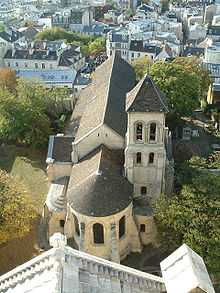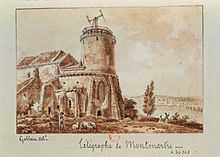Saint-Pierre de Montmartre

The Church of Saint Peter of Montmartre (French: église Saint-Pierre de Montmartre) is the lesser known of the two main churches in Montmartre in Paris, the other being the 19th-century Sacré-Cœur Basilica. According to the earliest biography of Saint Ignatius Loyola, the church is the location at which the vows were taken that led to the founding of the Society of Jesus.
History
Though according to its traditional history, it was founded by Saint Denis in the third century, only scattered signs of Gallo-Roman occupation have been detected at the much-disturbed site,[1] where Théodore Vacquier, the first municipal archaeologist of Paris, identified remains of walling as belonging to the Temple of Mars, from which Montmartre took its name.[2] In 1657, the antiquary and local historian Henri Sauval was shown remains in the priory garden that he associated with the templum Martis. The early church[3] that was a stop in the ninth century for pilgrims en route for the Saint Denis Basilica,[4] belonged in 1096 to the comte de Melun. Louis VI purchased it in 1133, in order to establish in it the Montmartre Abbey, and the Merovingian church was rebuilt; it was reconsecrated by Pope Eugenius III in 1147, in a splendid royal ceremony where Bernard of Clairvaux and Peter, Abbot of Cluny acted as acolytes.[5]

The 1670s and early 1680s marked a special moment in the history of the abbey. During the years when Françoise Renée de Lorraine, the sister of Marie, Duchess of Guise, was abbess, and especially while Marguerite Louise d'Orléans, Grand Duchess of Tuscany, was in confined residence there (starting in 1675), music came to play an important role in the abbey religious services. Marc-Antoine Charpentier, Marie's composer, wrote devotional music to be performed there. The Benedictine community moved downhill to a new priory in the 1680s. Saint-Pierre de Montmartre was destroyed during the French Revolution, and upon its apse was erected a tower for the purpose of the Chappe optical semaphore (illustration). The church was rebuilt in the 19th century, and today is visited by numerous tourists who tend to notice, among other things, the columns of Roman origin used in the nave.

Notes
- ↑ Bailey K. Young, "Archaeology in an Urban Setting: Excavations at Saint-Pierre-de-Montmartre, Paris, 1975-1977", Journal of Field Archaeology 5.3 (Autumn 1978), pp. 319-329. The retaining wall of Sacré-Cœur (constructed in 1875) stands at the eastern edge of the much-reduced monastery site.
- ↑ The toponym Mons Martis ("Mount of Mars") survived into Merovingian times, Christianised as Montmartre.
- ↑ Gregory of Tours does not mention it among the churches of Paris, because Montmartre was not a part of Paris, but the Merovingian cemetery dates to the sixth and seventh centuries (Young 1978:321).
- ↑ Miracles of Saint Denis, ninth century, is the first reference to the church.
- ↑ Young 1978:321.
Sources and external links
| Wikimedia Commons has media related to Saint-Pierre de Montmartre. |
Coordinates: 48°53′12″N 2°20′31″E / 48.88667°N 2.34194°E